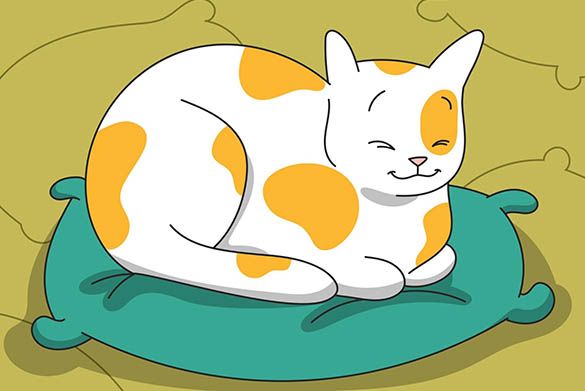Cats spend a generous amount of each day asleep. They’ve perfected the art of catching a snooze to such a degree that they effortlessly invented the cat nap.
As a cat owner, you will notice the weird and sometimes seemingly impossible positions cats sleep in. As it turns out, there’s a lot that your cat’s sleeping position can tell you about their state of mind.
Stop Googling - Ask a Real Vet
The Cat Loaf
The Cat Loaf is an iconic cat move. This is when your cat tucks all its paws in underneath its body and curls its tail around its body, making a neat, compact ‘loaf’.
When your cat assumes this neatly packaged position it shows that kitty is taking a little pause but is still attentive to what’s going on and ready to spring into action should the need arise. This is usually a very temporary state and shows your cat is not 100% at ease.
Cats in the loaf position are likely not sleeping deeply but dozing lightly. This may also be an indication that your cat is cold and trying to conserve heat.
When your cat keeps its back paws tucked in but shoots the front paws out just in front of them, this converts The Cat Loaf into The Sphynx — they’re still dosing lightly, but ready to leap into action if needed. Shooting the front paws out even further while the back feet stay tucked is known as The Superman and indicates a comfortable cat who’s enjoying a deeper sleep than The Cat Loaf.
The Ball
Don’t think that your cat feels uncomfortable in this position. On the contrary, this is a very common sleeping position for cats. Cats, just like humans, have many different sleeping positions. Cats are used to curling up in a small ball with their backs to the world.
For example, in this position, your fur pet cat can enjoy a deeper sleep, safe in the knowledge that its most vulnerable belly area is protected. “The Ball” will help your cat relax. It resembles the position of an embryo, in which a human also feels safe and relaxed.
Another reason for curling up can be a cold floor. So the cat will curl up to keep warm. Put the cat in a warm place then he can feel more cozy and relaxed.
According to the research, cats usually curl up into a ball with a bent neck when they are just beginning to fall asleep. If you see your pet flexing his neck, let him be in silence. It's a sign that muscles are not entirely relaxed and preserve tone, and the cat can easily awaken. Just let him completely relax and fall asleep.
Belly up
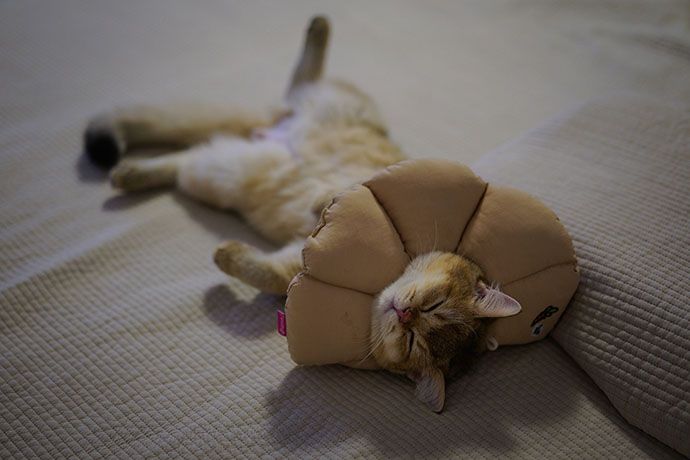
If your cat sleeps on their back around you, give yourself a pat on the back. This means your cat is completely relaxed around you and feels safe in your presence.
A cat’s belly is its most vulnerable area, so if your cat exposes this to you, it’s basically them saying “I trust you completely”. That they’re happy to fall asleep around you in this vulnerable position is a huge deal. This is a sign of pretty great pawrenting on your part — well done!
The Side Sleeper
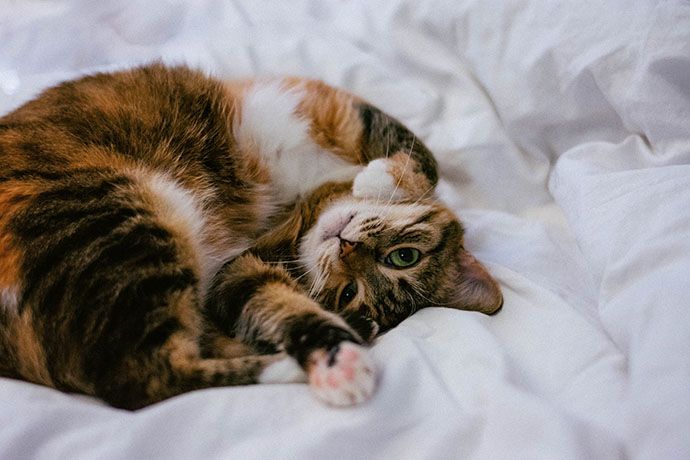
Much like The Belly Up, this position involves your cat partially exposing their most vulnerable belly area. A cat sleeping on their side is feeling super relaxed and is probably enjoying a deep sleep.
Hint: try not to wake a cat that is sleeping deeply. It makes them cranky. And cats hold grudges.
The Snug
Is your cat sleeping in a box or in a tight space? This is common behavior for a cat who might be feeling insecure or threatened. Something is unsettling your floof or they may be feeling unwell.
If your cat is suddenly seeking out a box or a snug space to sleep in, it might be a sign that something is afoot and maybe a trip to the vet is in order.
If your veterinarian always has a line of visitors and it's hard to make an appointment, it's a good idea to subscribe to the Pet Emergency Fund. This alternative pet insurance costs less than $1 per day for all your pets and gives you 24/7 access to a certified veterinarian. You won't have to wait in line anymore and imagine horrible pictures of possible diagnoses. Just write and get an answer! In addition, in case of emergency, this insurance will cover part of your bills.
The DND
Ok, this is arguably the cutest cat sleeping position. A soft paw draped across the eyes is usually a sign that your cat doesn’t want to be disturbed. A little dramatic, but that’s cats for you.
It is also likely a way to block out annoying light, a-la sleep mask. The diva energy is strong in this position, dahling.
But, actually, anytime your cat is sleeping face down or with its head tucked into a corner or buried, this is a polite way for your cat to tell you to leave them alone. It might also just be a way to avoid light or warm a cold little nose.
The Monorail
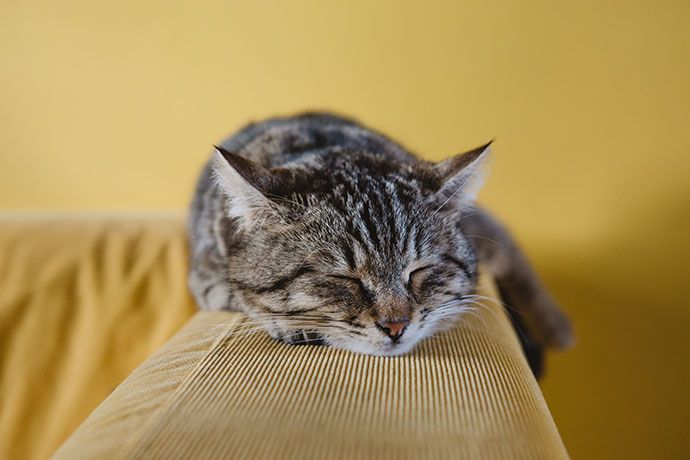
When a cat lies along the back of the sofa, along the arms of a chair, on a banister or wall, and lets one or more of its limbs dangle down, this is known as The Monorail.
Usually, the preferred locations for a Monorail offer your cat a great vantage point from which to observe their surroundings. They’re resting but keeping an eye on things to be safe.
The Peeper
Fun cat fact: it is entirely possible for your cat to be asleep AND awake at the same time. This is a handy cat safety feature that allows them to catch a snooze while still being observant of any threats.
Usually, only one eye is slightly open to keep an eye on the surroundings, and in a nutshell, when this happens, your cat is engaging in unihemispheric slow-wave sleep. What this means is that one half of your furkid’s brain is sleeping, and the other half is awake. Cool!
When you’re away but still want to interact with your pet, the Petcube Play 2 is your best bet. Since your pet is half awake in the “Peeper” position, you can still play with them using Petcube Play 2’s laser toy feature. You can play a game of real time chase with them, or you can set it on autoplay to keep them engaged in times when you are busy.
Apart from Petcube Play 2’s laser toy feature, it also has an impressive 1080p HD live video, a 160° full room coverage, night vision, and 8× digital zoom if you want to view the details.
Broken Kitty
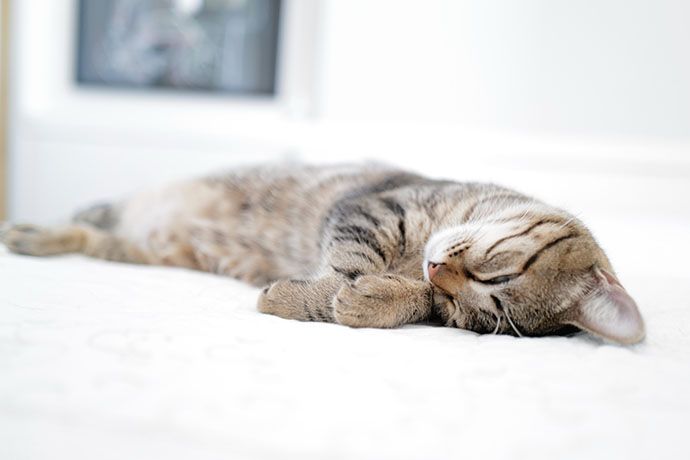
“Honey, I think the cat’s broken.” Also known as The Contortionist.
This is when your cat sleeps in impossibly contorted positions that don’t look at all comfortable. Back legs going in one direction and front paws in another, head bent at an awkward angle – we’ve all seen it, and if we didn’t know better, we’d suspect foul play.
It doesn’t look comfortable. It doesn’t even look possible. And yet, Sir Pounce is slumbering away sweetly.
There’s no reason for your cat to assume these advanced-level yoga positions. The consensus is that, actually, your cat just likes to sleep like that.
A good way to keep tabs on your cat’s body language (including sleeping position & the position and movements of their ears and tail) is by having a good pet camera such as the Petcube Cam. With its high-quality and innovative features, you can monitor their behavior or any symptoms that they may be exhibiting. What’s better is that it also comes with an online vet service, so you can consult with certified vets regarding anything that you observe about your pet’s health or behavior.
Read more: What Does It Mean When Your Cat Sleeps on You?
Final thoughts
Your cats sleeping position can tell you a lot about the emotional state of your cat. If you want more accuracy in your reading of your cat’s body language, look at things like ears and tails.
Ears that are moving around while your cat is sleeping indicate that your kitty might not be in a deep sleep or totally at ease because they’re keeping alert for sounds of a threat.
It’s commonly understood that one of the most obvious barometer of a cat’s emotional state is their tail. A tail that is twitching or swishing indicates a cat that is not entirely at ease.
Changes in your cats sleeping behavior can sometimes indicate that something is wrong. If your cat is suddenly sleeping significantly more or less, or seeking a hiding place to sleep in, it may be time to visit your vet to investigate. It may be likely that your cat is in pain or feeling unwell in some way.
Was this article helpful?
Help us make our articles even better

